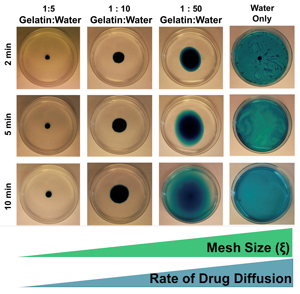URMC / Labs / Benoit Lab / Outreach / Middle School Biomaterials Education
Biomaterials for Controlled Delivery of Cells and Drugs: The Helpful Hydrogel

Hydrogel composition controlling the diffusion of food coloring through hydrogels
The student chapter of the Society for Biomaterials at the University of Rochester, under the direction of chapter advisor Dr. Danielle Benoit, participated in the Society for Biomaterials' 2013 Biomaterials Education Challenge. The team was tasked with developing an educational module for middle school science classrooms that demonstrated fundamental biomaterials concepts. The module the chapter developed, Biomaterials for Controlled Delivery of Cells and Drugs: The Helpful Hydrogel
was designed to be hands-on, be performed with easily obtained materials, and be easily incorporated into middle school science curriculum. Using widely available materials, the module helps teachers lead students through an investigation of how the stiffness of tissues in the body vary based on their function, and about the importance of matching biomaterial and host tissue stiffness. The exciting concept of stem cells, their applications in tissue healing, and the role biomaterials play in controlling stem cell behavior is also discussed. Using gelatin (Jell-O®) hydrogels as a model system, the module demonstrates how material properties can be tuned to control cell behavior and for use in different tissue environments. Students also investigate how alterations in hydrogel composition can be used to control the rate of drug release within the body by examining the diffusion of food coloring through hydrogels by varying the weight percent gelatin. This allows investigation into the relationship between the rate of drug diffusion and hydrogel properties such as mesh size.
The module was presented by chapter president Amy Van Hove and vice president Michael Hoffman at the 2013 Society for Biomaterials conference, and has been made available online. The chapter hopes that the module will be adopted by middle school science teachers, and that it will help encourage student engagement in science at the middle school level, and help increase widespread understanding of the field of biomaterials and biomedical engineering.
Files